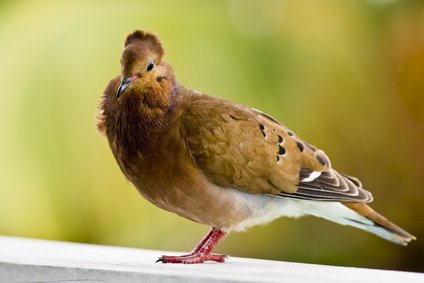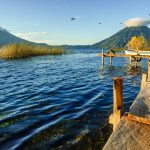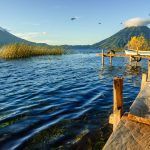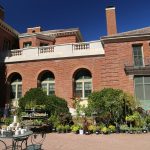 What did I know about birds? Enough to feed spinach greens, not stale muffins, to the domestic ducks at Recreation Park in my hometown of Long Beach, CA. Enough to avoid annoying the thirty-pound swans in London’s Hyde Park. Enough to understand that silence was golden while trailing knowledgeable birdwatchers in the woods near The House of the Doves at Uxmal. And once, at my grandmother’s house in Los Angeles when I was ten, I learned the hard way that it’s wise to avoid poking a thumb inside a budgie’s cage.
What did I know about birds? Enough to feed spinach greens, not stale muffins, to the domestic ducks at Recreation Park in my hometown of Long Beach, CA. Enough to avoid annoying the thirty-pound swans in London’s Hyde Park. Enough to understand that silence was golden while trailing knowledgeable birdwatchers in the woods near The House of the Doves at Uxmal. And once, at my grandmother’s house in Los Angeles when I was ten, I learned the hard way that it’s wise to avoid poking a thumb inside a budgie’s cage.
But otherwise in l990 when I first moved to Antigua, Guatemala, my birder knowledge was…for the birds. Or at least Kelly saw it that way.
Kelly, my housemate, often had trekked the John Muir trails with binoculars, packsack and pen. Now he sat for hours on our sundeck peering into our neighbor’s coffee finca, tallying the varieties of feathered creatures that fluttered among the overarching trees.
“Birding is the number one sport in America. It even beats basketball,” this lifelong Lakers lover announced. “And here there’s over 700 species of birds. You’ve got to pay attention. This is a once in a lifetime opportunity for a bird watcher!”
That afternoon he brought me a guide to local Aves from Un Poco de Todo, the bookshop nook facing the Antigua Parque Central.
“Don’t put this aside,” he cautioned. “I don’t want you to miss out.”
That sunset we sat on the deck sipping Gallo, the local beer. Suddenly Kelly cocked his head toward the flame-hued bougainvillea vine that draped the brick wall separating our sunken garden from the finca. “Just listen to that warbler!”
Kelly had a fine-tuned ear, once pointing out that a flush of California quail that we startled from the manzanitas of the San Gabriel Mountains chorused the opening notes of “Chicago.”
I nodded. “I hear it. It sounds like more than one bird.”
When it came to bird clatters, I scarcely could distinguish a skylark’s carol from a barn owl’s screech. What I heard now was a harsh, persistent trill, okey dokey, okey dokey, tweet, tweet, tweet, followed by a cacophony of raucous caws and kissy sounds.
Kelly shook his head. “Just one.”
“Is it a crow?”
Kelly laughed. “It’s a mockingbird! Most likely a bachelor. The males without mates usually are the ones who sing at night.”
I took another swallow of my Gallo. “All right, Mr. Ornithology, I’ll learn. I promise.” Kelly grinned.
So I spent my spare moments studying my manual. Here in the highlands, I read, we had brown-backed solitaires and black-headed siskins, gray silky-flycatchers and blue-throated motmots, white-winged tanagers and green-throated mountain-gems. I loved the rhythm of the names, and hoped soon to be able to single out some of these rainbow-hued creatures.
As the months went by with Kelly’s help I grew defter at identifying the guests that lounged in our gardens. From time to time I’d point out the iridescent beryline hummingbirds, here called “garden jewels,” darting on invisible wings among the fuchsia shrubs, or the turquoise bushy-crested jays nesting in nearby trees.
From time to time we entertained more exotic visitors, as an occasional orange-fronted parakeet or emerald toucanet dropped in, attracted to the peachy smell of plumeria in the sunken garden. However, I had yet to see a parrot in the wild.
My manual said that scarlet macaws, las guacamayas, the national bird of neighboring Honduras, preferred rainforests, but had been known to frequent higher elevations. These magnificent birds, in population decline throughout Central America because of parrot poachers and deforestation, had been spotted in Antigua, but rarely.
“Most of all, I long to see a scarlet macaw,” I confided to Kelly on New Year’s Eve. “That would be a once in a lifetime event, like a total eclipse of the sun.”
Kelly eyed me strangely. “Funny you mentioned an eclipse,” he said. “In a few months, in July, we’re going to have one right here in Antigua, and we can watch it from the sundeck.”
In the Guatemala Times, an English-language paper, we read how commentators were broadcasting warnings not to look directly at the sun during the upcoming event. They advised people to watch the eclipse on television to avoid risk of eye damage, so Kelly joked that we should just listen to the eclipse on the radio for complete protection.
We felt lucky. Thousands of people would travel to Hawaii or to Baja to stand in the shadow of the moon. We had merely to stroll out to our sundeck to witness darkness at noon. The totality of the eclipse would last nearly seven minutes, the longest that would take place for the next 141 years.
Though I was more interested in how wild birds would react to “the day of two dawns,” as I had taken to calling it, most of our ex pat friends merely predicted that roosters would crow at midday. Local gossip focused on how Maya in the remote rural areas would behave, whether old superstitions would prevail even in l991. Would pregnant women fear that they would miscarry or give birth to hare-lipped babies? Would shamans predict earthquakes, droughts, or other disasters?
When July 11 arrived Kelly and I settled into our deck chairs on the patio, with shaded eclipse glasses, macadamias and mimosas at the ready. Around noon dogs begin to bay as the moon bit into western edge of the sun. Birds in the finca drifted upwards to roost in the trees.
Soon tiny spots of light, shining through overhead leaves, showed up on our deck as crescent images. The daylight somehow had fractured. I glanced at the walls of the Hotel Antigua across the way and observed thin wavy lines of alternating light and dark that I later learned were shadow bands, resulting from sunlight distorted by irregularities in the Earth’s atmosphere.
Suddenly the sky grew dark. We knew this was second contact and that it was safe to witness the full glory of the sun’s corona shimmering overhead. The hibiscus flowers in the sunken garden began to fold inwards. The birds ceased their chirrup. I felt the temperature drop. We watched the stars emerge, and singled out Venus.
Several minutes later we looked away as the sky lightened. Sure enough roosters crowed. Kelly, staring over my shoulder, caught my eye and whispered, “Slowly, slowly turn your head to the right.”
I casually swiveled my head until my eyes fell on a scarlet macaw, blending into the magenta bougainvillea bracts. About three feet long, from its crown to the tip of its bright red tail feathers, I figured it for a male.
“Offer it a nut,” Kelly prompted. I extracted a macadamia from the dish. The macaw watched me silently. I rolled the nut gently along the brick wall in the bird’s direction. He reached out his left talon and snatched it up. In apparent thanks, he emitted a low-pitched throaty squawk, nodded his head, spread his wings and flew back to the finca.
By the time I left Guatemala a year later, I had traded my birder manual for a Spanish textbook, since I was heading to the Dominican Republic to serve as a Peace Corps Volunteer. Kelly, who remained in Antigua, wrote me frequently. No scarlet macaws ever showed up again, he said. Just parakeets and toucanets.
Years later I experienced a second total solar eclipse, this one on the Black Sea. This time I witnessed the confused behavior of terns and other seabirds, but, alas, not a single scarlet macaw appeared. Not that I was expecting one. I’ve learned enough about birds, and life, to know that some things really do happen just once in a lifetime…and are worth waiting for.







Leave a Reply